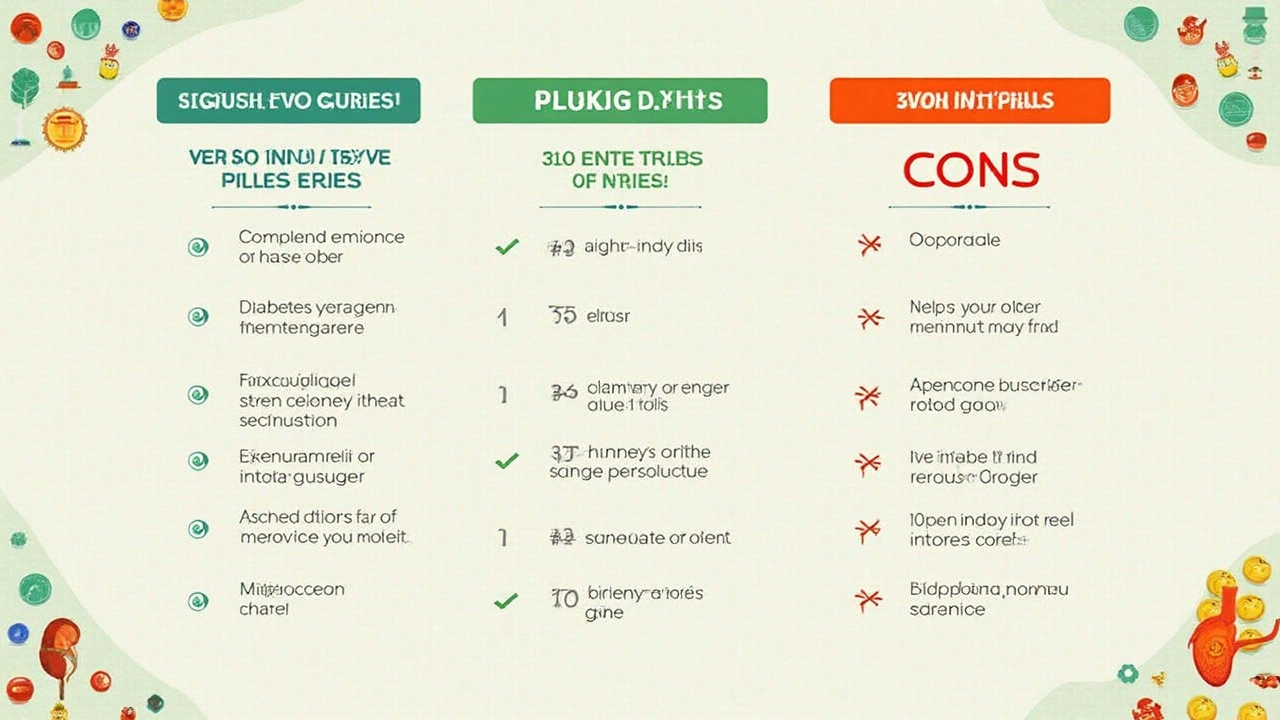
Pop quiz: What’s the biggest fear about starting a new diabetes pill? For most people, it’s the side effects and long-term safety. No one wants to trade stable blood sugar for a trip to the ER, right? Stories from friends, sensational headlines, and every doctor’s slightly different advice—it's enough to make anyone confused. Yet, with diabetes rates climbing, more of us face the pill-picking challenge. So what actually is the safest diabetic pill? Let’s clear up the confusion, skip the scare tactics, and break down the hard facts.
Decoding "Safety" in Diabetes Pills
We all want a simple answer—just tell me the safest pill! But hold up a second: “safe” means different things to different people. For some, it’s about the lowest risk of dangerous side effects. For others, it’s avoiding weird long-term problems, like kidney issues or weight gain. Here’s the twist: our bodies process medications differently, so what’s safe for your neighbor isn’t always the best for you.
There are two big types of diabetes: type 1, which almost always means insulin, and type 2, which often starts with lifestyle changes and those mysterious “oral agents.” We’re focusing mainly on these pills for type 2. And the variety is wild—over 60 different branded and generic options. Science keeps marching on. Just last year, the FDA recalled two generic metformin products for contamination concerns, even though metformin itself is legendary for its safety. No medication is totally free of risks.
Metformin constantly tops the charts for safest and most trusted type 2 diabetes drug. Over 150 million people worldwide use it, and it’s often the first pill a doctor suggests.
But doctors look at more than just the pill. A big, randomized 2022 study published in the New England Journal of Medicine compared "add-on" pills—those used when metformin isn’t enough. The results? SGLT2 inhibitors (like empagliflozin) and GLP-1 agonists (like semaglutide) both showed safety benefits in people with heart issues, but long-term data is limited compared to old-school drugs. Let’s dig into the main classes one by one, because each has a different safety story.
Main Types of Oral Diabetes Pills and Their Safety Records
Metformin is like the old friend everyone trusts. It’s been around since the 1950s, with over half a century of follow-up. Its top safety perk? Very low risk of low blood sugar (hypoglycemia), and it also helps many people lose a bit of weight. In rare cases (less than 1 in 10,000), it can cause lactic acidosis, especially if kidneys aren’t working well. But the real-world numbers show this is ridiculously rare—one British study found less than three cases per 100,000 users per year. Metformin does sometimes cause belly issues (bloating, diarrhea), but these usually go away after a few weeks or with an extended-release version.
Next up, Sulfonylureas. These are the old-school, bargain-bin pills—think glimepiride or glyburide. They’re super effective at lowering blood sugar, but their safety isn’t great for everyone. About 1 in 7 older adults on sulfonylureas experience low blood sugar episodes bad enough to require help, according to a 2021 CDC review. They can also push weight up, which is not ideal if you’re already battling extra pounds.
SGLT2 inhibitors (like canagliflozin, dapagliflozin) are newer and were a big focus in recent safety studies. Their claim to fame is protecting the heart and kidneys, but they can cause urinary tract infections, yeast infections, and—rarely—dangerous ketoacidosis. The chance of amputation with some drugs in this class spooked people, but real-life data on this is less alarming than early reports suggested. Still, doctors keep an eye out when prescribing them.
GLP-1 agonists (like semaglutide, liraglutide) are all over the news because they help with weight loss as well as blood sugar. Side effects (nausea, vomiting) are a real thing but usually settle down. Pancreatitis risk exists but is rare (1-2 cases per 1,000 users, based on a 2023 French national study).
DPP-4 inhibitors (like sitagliptin) and thiazolidinediones (like pioglitazone) round out the bunch. DPP-4s are considered pretty safe, causing maybe a small uptick in joint pain or sinus infections. Pioglitazone can be nifty for some, but it’s flagged in people with heart failure or bladder cancer history.
So, which is safest? If safety means lowest risk in an “average” person, metformin wins. But the right answer depends on your age, medical history, kidney function, and lifestyle.
Side Effects: Sorting Myths from Reality
When you Google a new diabetes pill, up pop horror stories about sudden kidney failure or hospital trips from low blood sugar. Let’s be real: most of these aren’t the full picture. Most people never get serious side effects. But, you want numbers, not just reassurance, so here’s a cheat sheet:
- Metformin: Bloating or loose stools in 8 out of 10 people at first, dropping to 1 in 10 after a month. Lactic acidosis risk is 0.015% but higher if your kidneys are bad.
- Sulfonylureas: Low blood sugar needing help: 1 in 7 adults, especially if over 60 or missing meals. Weight gain: average of 4-6 pounds in 6 months.
- SGLT2 inhibitors: UTIs or genital infections: 5-8% risk, most mild. Diabetic ketoacidosis: 1 in 1,000, mostly in people with other risk factors.
- GLP-1 agonists: Nausea or vomiting: up to 1 in 4, usually early on or after a dose change. Pancreatitis: around 1 in 1,000.
- DPP-4 inhibitors: Minor: maybe headaches or stuffy nose. Joint pain: 1 in 200.
Some pills get bad press but aren’t actually dangerous for most. Remember the panic about metformin causing cancer a few years ago? That was contamination in one generic, not metformin itself. Agencies like the FDA quickly pulled the batch.
Another common myth: oral pills always beat insulin for safety. Not quite true—well-titrated insulin isn't riskier than many oral drugs once someone knows how to use it. Pills do win for convenience, and for people who hate needles, obviously.

Who Decides the "Safest" For You?
No single test ranks a pill as the best for everyone. I’ll share how my wife Mira’s doctor explained it: They look at diabetes history, weight, heart health, kidney function, and even insurance coverage in one giant decision-making soup. For instance, people with chronic kidney issues ditch metformin and SGLT2 inhibitors. Folks with a heart attack history often get SGLT2 or GLP-1 options because they reduce risk of future cardiac problems. Want to avoid injections? DPP-4 or SGLT2 pills might be first-line after metformin.
Doctors also factor in your “risk tolerance.” Some people are willing to take a small risk for bigger benefits—others want the lowest risk possible, even if it means sacrificing a little on blood sugar numbers.
Keep this in mind: Dosage matters. Many side effects drop dramatically if you start with a low dose and build up slowly. New guidelines from the American Diabetes Association in 2025 now encourage “start low, go slow” for nearly all diabetes meds—something every clinic is following.
If you’re still unsure, here’s a quick-glance safety comparison table. It’s not a substitute for your doctor’s advice, but it puts numbers into perspective:
| Pill Class | Biggest Safety Plus | Most Common Side Effect | Rare But Serious Risk |
|---|---|---|---|
| Metformin | Low hypoglycemia, long-term safety | Stomach upset | Lactic acidosis (rare) |
| Sulfonylureas | Inexpensive, powerful sugar effect | Low blood sugar, weight gain | Severe hypoglycemia |
| SGLT2 inhibitors | Heart/kidney protection | UTIs, yeast infection | Ketoacidosis, amputation (rare) |
| GLP-1 agonists | Weight loss, heart protection | GI side effects | Pancreatitis (rare) |
| DPP-4 inhibitors | Low side effect risk | Joint pain | Pancreatitis (very rare) |
Tips for a Safer Diabetes Medication Experience
Maybe you’ve seen your dad hide pill bottles or your friend swear off diabetes meds after a bad experience. The safest pill is only as safe as the way it’s taken. You can really tip the scales in your favor with a few smart habits:
- Stick to your schedule: Skipping doses raises risks, especially for sulfonylureas and insulin. Alarms or phone reminders help.
- Get regular labs: Metformin and SGLT2 inhibitors need routine kidney checks, usually every 6-12 months. Skipping labs is the most common cause behind missed complications, per recent CDC reports.
- Speak up fast about side effects: Mild tummy trouble after starting metformin is totally normal. But if you get shortness of breath, swelling, or confusion, call your clinic now—not next week.
- Don’t ignore the small print: Drug interactions sneak up fast. Even over-the-counter allergy meds or supplements can mess with your blood sugar or cause new side effects.
- Know which pills to skip during sickness or before surgery: Metformin and SGLT2s can build up if you’re dehydrated or have an infection. Double-check with your doctor if you’re not eating much for a day or two.
Here’s a cool stat: People who keep a simple log (not even a full journal—just a notebook or phone app) about side effects and blood sugars report more satisfaction and less confusion. Just five minutes a week makes a difference. My wife swears by a color-coded pill organizer; she’s never missed a dose since.
Remember, even the safest pill sometimes isn’t “good enough” if diet, activity, and weight aren’t managed. Doctors now say the combo of pills PLUS lifestyle wins every time.
The Future of Safe Diabetes Pills
It’s wild, but the story of diabetes medication safety changes every year. Researchers are working on new once-a-week pills, combo drugs that hit different targets at once, and even oral insulin that doesn’t break down in the stomach. Many next-gen drugs aim to be “weight-neutral” (no extra pounds) and gentler on kidneys. By 2025, the ADA and European diabetes societies now recommend early use of SGLT2 or GLP-1 for anyone with heart or kidney risk, which means the definition of “safe” is shifting too.
If you’re starting or switching diabetes medication, don’t sweat the Internet rumor mill. Use realistic data, honest conversations with your doctor, and keep your own tiny notebook or app log. The safest diabetic pill today? Metformin is the top answer—unless your situation points to a slam-dunk reason for something else. The good news is this: doctors and scientists are getting better, faster, and safer every year. That means more options, less worry, and better lives for millions living with diabetes.






